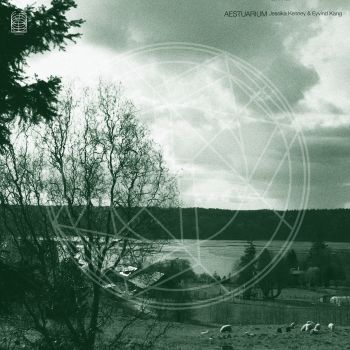When SUNN O))) guitarist and all-round drone/metal/experimental bigwig Stephen O’Malley was handed a curatorial role by Editions Mego to provide the albums for their new Ideologic Organ imprint, it would appear (at least at first glance) that he didn’t scout about too far to land his first release, as vocalist Jessika Kenney and violist Eyvind Kang both appeared on SUNN O)))’s monstrous 2009 opus Monoliths & Dimensions, the former directing the choir on ‘Big Church’, the latter providing string and acoustic arrangements on the same track and on ‘Alice’.
But as Ideologic Organ is dedicated to exploring "acoustic" music, in all its varied forms, you’d be wrong to be the expecting saturated guitars, cavernous vocals and doom-laden lyrics that one tends to associate with O’Malley’s own musical output. Aestuarium is a work of delicate beauty, as pristine as the surface of a lake at dawn on a summer’s morning.
Much of this is down to Kenney’s remarkable voice. It glides out of the speakers on opener ‘Orcus Pellicano’ like a quiet brook sliding down a mountainside. It’s clear and immediate, yet steeped in history, seeming to stretch towards the listener from across an ocean of time. Kenney sings in Latin, yet her phraseology seems to come from even further back, echoing traditional music from the pre-Roman Celtic civilisations of Ireland and Britain, steeping Aestuarium in a sense of occult paganism, as if Kenney had, prior to recording, uncovered a grimoire of ancient rites and was using them to channel the spirits of her pre-colonial ancestors.
Adapting the musical styles of lost civilisations for the modern times is a particularly treacherous exercise.
It’s one thing to cover folk tunes that have been handed down from generation to generation, à la Pentangle or Fairport Convention, but to try and recapture music that has mostly been forgotten, whilst all the while making it palatable for modern sensitivities, is another kettle of fish altogether. Just listen to the bile-inducing fluff of Enya or the Titanic soundtrack for particularly bad examples. On first reading about Aestuarium, I was worried it would sound like a dodgy Dark Ages film soundtrack. Instead, it may just be one of the best modern examples of a minimalist tradition that evidently stretches back into the mists of time, but came to a head from the early-60s-onward with the popularity of Indian masters like Pran Nath and Ravi Shankar, and the emergence of modern composers such as LaMonte Young, Marian Zazeela and Charlemagne Palestine; not so much in the actual style (the pieces on Aestuarium tend to be rather short and airy, as opposed to the lengthy deep drones of Young or Nath), but in the way Kenney and Kang stretch into the past and across borders to create arresting “new” drone and vocal music.
On ‘Figura Nox’, Kenney brings her interest in Middle Eastern music to the fore, her undulating chanting seeming more indebted to Persian or Maghrebin traditions than the Celtic tones of ‘Orcus Pellicano’. This globe-trotting never seems unsettling, though, as the whole of Aestuarium is dominated by the theme of water, from its recording on the banks of Puget Sound to the way it brings in a diversity of influences and phraseologies into one homogenous voice, in the same way cultures crossed oceans to come together in estuarine ports and cities, from Britain to America via Ancient Egypt and The Far East. Aestuarium is ideally suited to being listened to on a vast seashore on a windy day, watching gulls circle over listing cargo ships and choppy waters.
Incredibly, Kenney and Kang (sounds like a detective show duo…) achieve this broad and textured atmosphere with just vocals and viola. Eschewing any predictable call-and-response stereotypes, they combine the voice and strings to become one source, the deeper tones from Kang grounding the soaring vocalisations of Kenney. This is most effective on the spooky, hesitant ‘Unnamed Figures’, on which the two musicians edge around one another, almost seeming to duel as opposed to duet, both expertly poised, creating a tension that belies their stripped-down set-up. Kenney’s voice is mournful and aching, conjuring deep emotions from the sparsest of means. On ‘Dies Mei’, the loping vocal plays off against a percussive backing line, Kang’s virtuosity adding extra dynamism and building on the edginess of the previous track. But by the final piece, (relative) calm is restored. Kang allows himself a rare mini solo which segues into a tremulous vocal by his musical partner. And so the album slides away, like the tide receding from the shore, leaving a sense of having experienced something primal, timeless and haunting.
For all that Aestuarium sounds far removed from standard heavy O’Malley fare, it is easy to see what drew him to the album, beyond its obvious beauty. With its impenetrable lyrics, minimal, sparse arrangements and overarching sense of mystery and arcana, it is perfectly keyed in to the same Ur-klang (as Julian Cope would say) that informs the deepest recesses of SUNN O))) and Khanate’s music.
But beyond all that, Aestuarium is simply a stirring and beautiful album showcasing two premier musicians advancing into inventive forms of minimalist, but emotionally resonant, music. You can find layer upon layer of meaning in the grooves of this LP, and consider ad infinitum where it fits in the minimalist, or indeed O’Malley, cannons; or you can slap it on, close your eyes, and journey to the wild shorelines Jesskia Kenney and Eyvind Kang conjure up with their intense and beautiful sounds.


